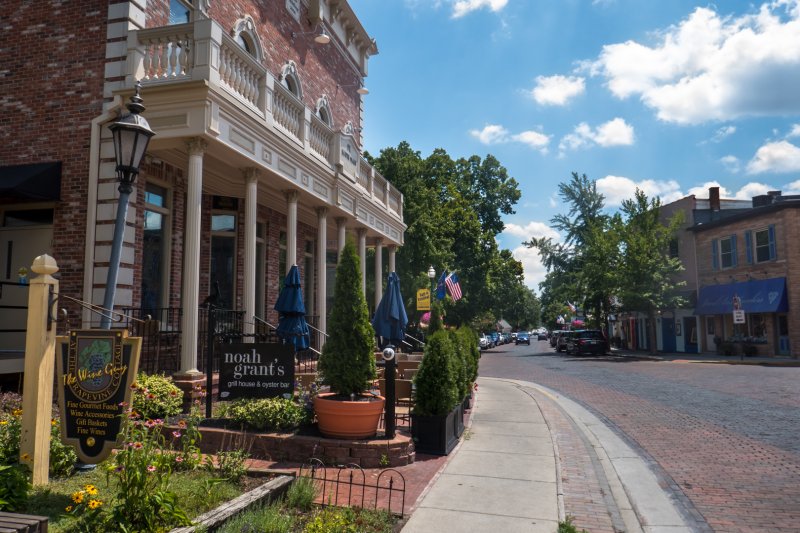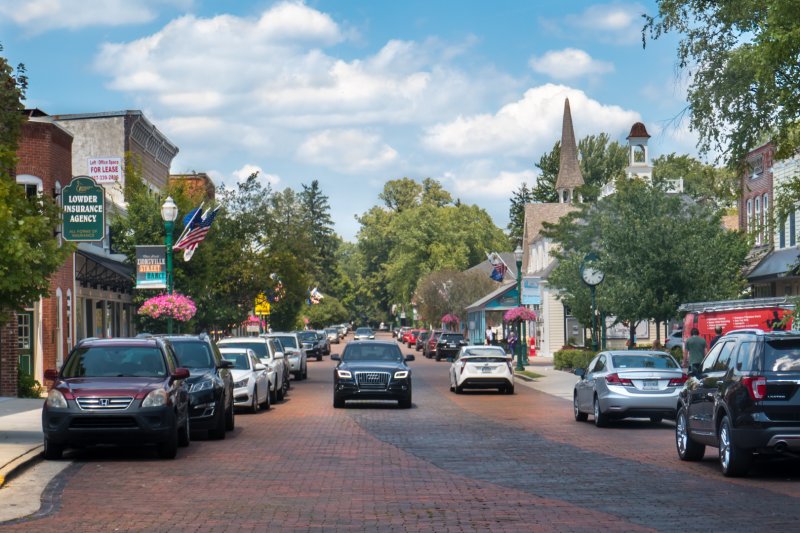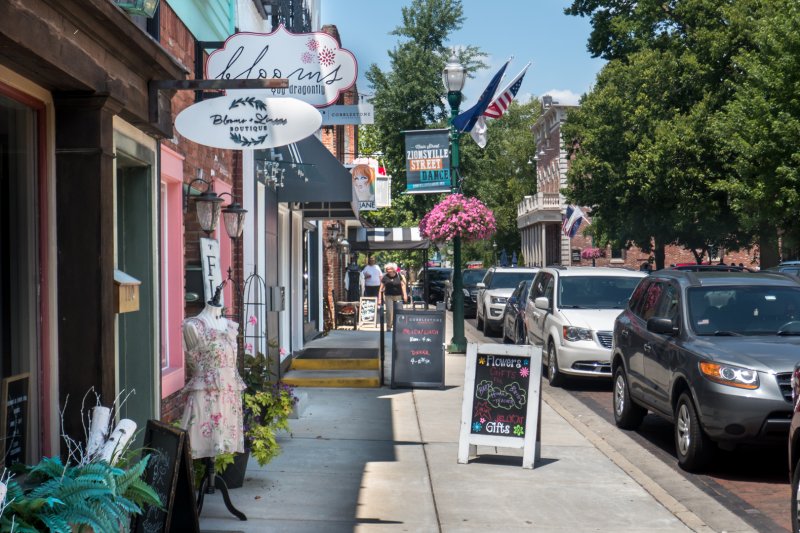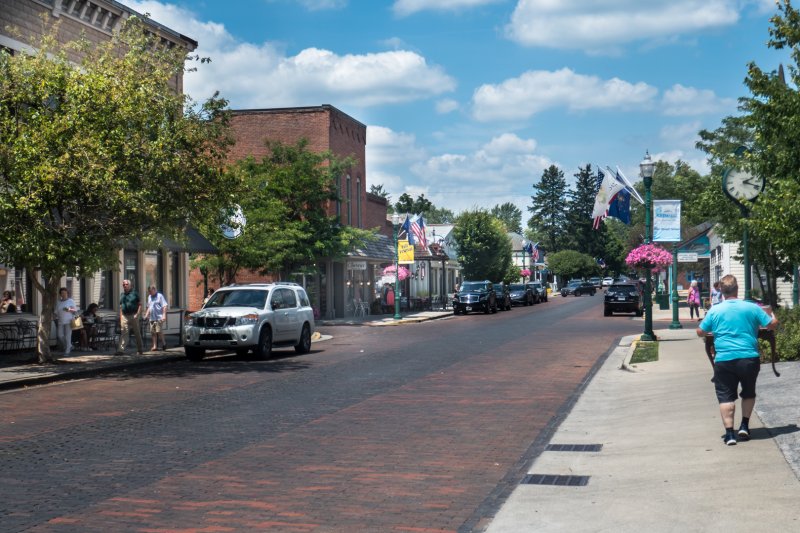
Urban Impressions: Zionsville, IN (Indianapolis Part 3)
To be honest, Zionsville, IN is not the type of place I would normally explore, let alone analyze in depth. In fact, had I not been staying in this small, rural-turned-suburban town just northwest of Indianapolis, I might not have paid it a second thought. Sitting right outside Interstate 465—the gigantic, square beltway that surrounds the city—Zionsville is one of the epicenters of suburban growth in greater Indianapolis. Its population has been exploding, nearly doubling in the past ten years alone. But while the town is mainly suburban, what makes it truly unique—not to mention economically successful—is its quasi urban core. Zionsville is centered on a quaint, compact downtown full of quirky shops—all of which are supported by acre after acre of nigh-exurban single family housing developments and big box stores. It should, by all rights, be a place I loathe, one that sells itself on its small-town-America charm, its driving proximity to central Indianapolis, and its tourist friendly nature. And yet, as with anything related to cities—even small ones—nothing is so simple, nor so clear cut.
Of course, some of this may well be Stockholm syndrome. After a few days of suburban Indiana, downtown Zionsville's urban nature—no matter how kitschy or artificial—offered a welcome respite. Having somewhat likened parts of Indianapolis's Fountain Square neighborhood to a theme park, I am painfully aware of my own potential hypocrisy. After all, no matter how troubling I find some of that neighborhood's development trends, it is still a long-struggling urban neighborhood striving to be more—and that is something that should be commended. In contrast, a place like Zionsville exists upon far more artifice: a cynical mind would not be entirely wrong to see its cute downtown as little more than an artisanal mall for rich, white suburbanites. And yet, just as a large part of me was uncomfortable with a cynical characterization of Fountain Square, I cannot bring myself to be fully smug and dismissive of this town, either. Zionsville is a far harder circle to square than it may appear at first glance. On the one hand, it is a surprisingly functional, delightfully gorgeous, nearly urban place, full of interesting shops and interacting people. The town stands as a shining example of the quasi-urban desires of the suburban class: of just how many otherwise proud suburban- and exurbanites still often seek out urban-like forms, at least on their own terms. On the other hand, however, the town is also a place founded upon rural and suburban fantasies of town life, on boutique consumption, and exclusion. In other words, Zionsville is a product of inseparable contradictions—and that, perhaps more than anything else, makes it quintessentially American.
Zionsville likes to sell itself as a destination for both tourists and local suburbanites by playing up not only its physical form, and since history and form are so deeply intertwined, that is as a good a place to start as any. Founded in 1852 by William Zion, the town was essentially a product of the railway, growing up around a station on the then-new Indianapolis and Lafayette Railroad. This was not necessarily the most auspicious start—the tiny line essentially only connected tiny rural communities to the still small city of Indianapolis—but it would soon prove somewhat fortuitous. As was so often the case in the nearly unrestrained capitalism of the late Nineteenth Century, the line would be merged and merged again, becoming part of ever bigger companies and ever bigger networks, eventually becoming part of the Cleveland, Cincinnati, Chicago, and St. Louis Railway—a mouthful of a name by any measure. Zionsville was in luck: the Big Four Railroad, as it was more commonly known, not only offered the town a direct connection to the rest of the country, but also a place on the busy mainline between Indianapolis and Chicago.
The impact of this national connectivity may best be highlighted by the name of a small square near the center of the town: Lincoln Park. Located one block off of Zionsville's Main Street, the park was not only the site of the town's original railroad station, but also its tenuous connection to Abraham Lincoln. The 16th president would indeed stop in Zionsville twice. The first time came in 1861, when the train carrying Lincoln to his inauguration stopped briefly in the town—long enough for the soon-to-be-president to give a whistle-stop speech. Lincoln would return, after a fashion, in 1865. This time, it was the train carrying the fallen leader back to his Springfield home that would momentarily break in the town, allowing mourners to pay their respects (on this visit, the president presumably did not give a speech). Zionsville is obviously proud of its small link to national history: beyond the name of the park and its commemorative brass plaque, there is also a bold, stylistic mural of the president across the street, proudly overlooking one of the main roads into town. While this may in part be a way to ginger up the history of an otherwise quiet, ordinary place—the real-world equivalent of the proverbial "Washington slept here" sign—it is also a living connection to a larger history, one which highlights just how impactful connections to national networks can be.
Still, what the railroad giveth, the railroad can take away, and early in the Twentieth Century, Zionsville would face a threat to its rail-based livelihood. The Big Four Railway had decided to straighten its mainline, which would include moving the station in Zionsville over a mile away from the town center—a huge impact in the pre-automotive age. Losing its connection to the outside world could well be fatal for any town, but Zionsville would have a savior: almost simultaneously, a new line would open that closely paralleled the old. In many ways, this new railway, the Terra Haute, Indianapolis, and Eastern—unwieldy geographic names apparently being in vogue at the time—represented a step up from the Big Four. It was an electric interurban, which directly connected downtown Zionsville and downtown Indianapolis with relatively frequent, comparatively inexpensive service. What's more, as was the case with many interurbans, the new line would run right along Main Street through the town, much like a streetcar. The line would prove formative: the vast majority of downtown Zionsville would be built directly along its route from the late 1890s through the 1910s. And again, the town isn't shy about embracing its history. Not only does the building which once contained the local depot bear a commemorative plaque, but Main Street itself is paved with bricks that roughly show the line's route through the town. It is a wonderfully clever, subtle nod to an important time in the town's past—one I readily admit I didn't recognize on my first visit.
Today, Zionsville remains centered on its small, urban-scaled core, having carefully maintained and invested in its downtown even as its population has exploded. It's easy to see why: so-called Old Zionsville is an undeniably cute, almost aggressively pleasant place to spend time. For around half a mile, Main Street is lined with small, attractive buildings, bountifully filled with small boutiques and restaurants. The short blocks and the tree-lined streets combine to create an intriguing environment for walking, one which not only invites you to stroll from one end to the other and back again, but makes doing so feel effortless. Like Indianapolis's Broad Ripple, shops are not entirely limited to Main Street, and a number of side streets continue the retail theme, giving the urban environment depth. The building stock itself is both attractive and visually interesting. Evenly split between single story wood clapboard buildings and two to three story brick structures—both classics of American small town urban form—they tend to be painted in vibrant colors, creating an engagingly striated visual experience. Porches and sidewalk-covering, wooden arcades are surprisingly common for a Northern town, and even the buildings without them tend to have awnings or other decorative outcroppings. All of these protrusions create not only shade, but visual variety. Points of interest are everywhere: stores explode out onto the sidewalk with signs and displays, and pieces of street furniture, like benches, are ubiquitous. Of course, these welcome affordances also somewhat hint at some of Zionsville's exclusionary policies: the town has isolated itself enough that it no longer shares the (sadly common) worry about "undesirables." Still, it's very easy to see why tourists and suburban shoppers flock here: this is an almost idyllic vision of urban form.
Sadly, however, few people actually live right in downtown Zionsville, or even within easy walking distance. Instead, the vast majority of the area's population lives in the auto-centric sprawl that defines the rest of the town and its environs—and as such, must drive to the center. Like most American downtowns, Main Street itself is almost entirely devoted to commerce: there are no obvious mixed use buildings here. Off of Main Street, there are a fair number of handsome suburban houses lining a small grid of streets around the core. Built by an earlier era to be within walking distance of the shops and the interurban, they almost look like a prototype New Urbanist development: smallish lots and a preponderance of porches encourage residents to walk and interact. Sadly, though, like all of America Zionsville sprawled instead of growing around its small, compact grid. Had it not, the town might be a very different kind of place, indeed.
Taking a step back and looking at it as a whole, however, downtown Zionsville is a maddeningly ambivalent place. On the one hand, there is no doubt that this is a rural/suburban fantasy of urban life—a real life version of Disney's Main Street USA where suburbanites can go to shop and dine in a comfortable, non-threatening, homogenous environment. Walking through the town, you feel the racial and economic uniformity. The shops paint an idyllic portrait of upper middle class life: the high-end used book and map store (dog included), the numerous clothing boutiques, the neatly organized antique stores, the art and yoga studios, the multitude of boutique bakeries, the high-end olive oil retailer, and more nice restaurants than I cared to count. At its worst, downtown Zionsville can feel like nothing more than an artisanal shopping mall. Even Lincoln Park's gazebo, which was being prepped for a summer wedding during my visit, felt spotlessly utopian: a picture perfect place for a picture perfect white wedding in a picture perfect white tourist spot.
And yet, try as I may, I can't quite maintain that level of cynicism with any honesty. For one thing, I am well aware that the lady doth protest too much: I am very much the target audience for a lot of this, and I can't help but find it somewhat charming—even through its cloyingness. More fundamentally, however, out and out cynicism does not offer a complete picture of downtown Zionsville. The town is not entirely a product of artifice. While its economy may be boutique, those boutiques are overwhelmingly small, independent businesses. It's not simply that chain stores and chain restaurants have been relegated out of downtown to the outlying suburban areas. This is a functional urban economy, operating on good, old-fashioned agglomeration economies. The scenic town and its quaint businesses pull in visitors like a magnet. This cavalcade of visitors, in turn, creates an even bigger market for more small businesses, which then attract more people, and so on. Zionsville's urban economy is a limited one, to be sure: it is based mostly on the consumptive dollars of suburban shoppers and regional tourists. Still, it is real, functioning, and homespun. There are even a handful of businesses that seem to target more local consumption, including a fancy butcher shop, a wine store, and a pizzeria, amongst others. These businesses may exist thanks to a surfeit of local capital, but that capital has been put to productive, profitable use. Zionsville demonstrates how something akin to an urban economy can take root even in small, mostly suburban places.
That being said, it is always far, far easier for an economy to take root when it already has a lot of capital to play with, and even the briefest look at census data will show that Zionsville is a surprisingly wealthy town. Interestingly, you often don't feel this wealth when walking the streets. The stores may be niche and kitschy, but there are few boutiques or restaurants here that rise to Veblen-esuqe levels of conspicuous consumption. The buildings may be well maintained and the streets may be elaborately paved in decorative brick, but there is little overt grandeur: even the surrounding houses, while handsome, are not huge. The people may be overwhelmingly white and economically secure, but the town does not feel like an exclusive enclave for the leisure class. In fact, I was all but ready to say that there is a Midwestern, workaday quality to the town's wealth—at least until I turned a corner off of Main Street and came face-to-face with a Bentley dealer. Sitting across the street from a neatly trimmed Dairy Queen, you would be hard-pressed to find a more symbolically resonant image of Zionsville's contradictions.
Stepping away from the comfy confines of Main Street is also a wake-up call of a different sort: no matter how pedestrian friendly downtown Zionsville may be, the town as a whole is still fundamentally a suburban, auto-centric place. You don't even have to walk far to see it: South First Street, for example, which parallels Main Street one block away, is a deeply uninviting place. Once part of the old railroad right of way, it was at some point reworked into a wide road designed to allow through traffic to bypass the town. The street may well keep some traffic out of the core, but its dead-faced strip malls and lifeless parking lots are a far cry from the street life that exists only a few steps away. Of course, the rest of Zionsville is even more suburban. Subdivisions, shopping centers, and big box stores line fast, arterial roads, covering over the recently rural landscape. As a result, downtown Zionsville is very much a product of drive-to urbanism: most shoppers and workers must arrive via car. In that regard, the town has done about as well is it can. Numerous small parking lots sit just off of Main Street, which encourages you to get out of your car and walk, not circle for the closest spot. It isn't perfect—and a change to land-use regulation would be a far better long term solution—but given the small population living nearby and the absence of any transit options, it is an okay compromise. Still, if the Indianapolis region is serious about pursuing an urban future, it would be wise not to ignore Zionsville, which would still make an ideal stopping point for a reliable, regional system of mass transit—just as it was for much of its history.
Sadly, effecting such a connection may be an uphill political battle, thanks in large part to some uncomfortable history. One of the major reasons for the explosive growth of Zionsville—not to mention many of the other suburban towns surrounding Indianapolis—may well lie in a political decision made in 1970. That year, the city of Indianapolis and its surrounding county, Marion, were merged into one unified government—the ominously titled Unigov. Although the political union of city and suburb has long been advocated as a means of increasing regional equity, even at the time this union was often seen in stark racial and economic terms: it allowed a more affluent, whiter population to remain in control of a city that was fast becoming poorer and more racially diverse. Perhaps tellingly, while most city services were merged in 1970, school districts were not—and as with much of the country, they remain deeply unequal. Unigov has arguably had its successes: the larger tax base, for example, allowed the city to build a convention center, multiple major league stadiums, and downtown parks to reclaim the riverfront, all of which some credit with keeping the city on the economic map. However, it also allowed a distinctly suburban population to remain in control of the central city for some thirty or forty years longer than might otherwise have been possible.
Zionsville, which lies just over the border in neighboring Boone County, did see a notable uptick in population between 1970 and 1980, right after the formation of Unigov. Explosive growth, however, has only really come in the last two decades—concomitant with Indianapolis itself beginning to tilt back towards more diverse political control. And while Indianapolis proper has grown, its exclusionary suburbs, such as Zionsville and nearby Carmel, have grown even faster. In fact, between 2010 and 2018, Zionsville nearly doubled in size, growing from approximately 14,000 to 27,000 residents. Of course, not all of this growth can be attributed to the ugly politics of race and class. Not only is Zionsville, as we've already discussed, an almost uniquely gorgeous oasis in a land of suburbs, but the movement of people is a complex topic rarely reducible to one or two simple factors. Still, even in this era of metropolitan growth, many of the country's past suburban fears obviously remain potent. America's subsidized suburban machine remains in full swing, and as a result, exclusionary suburbs continue to grow at a breakneck pace.
All of which makes coming to grips with Zionsville difficult. If this were a high school essay—or if I were in a cheeky mood—I might write that, "In conclusion, Zionsville is a town of contrasts." Sometimes, an ambivalent reality demands a cliché—nothing else will do it justice. Zionsville is multiple places layered atop one another. On the one hand, it is an artificial piece of faux urbanism, supported by wealth, exclusionary policies, auto subsidies, and above all, the artisanal consumption of tourists and suburbanites. On the other hand, it is also a real town, made up of real people, which has managed to maintain a gorgeous, deeply walkable downtown and an admirably homespun, thriving local economy amongst a backdrop of subdivisions and chains. There are many contradictions. The town thrives on its urban qualities, but loves to promote its own small-town-near-the-big-city virtues. All across Zionsville are heartfelt signs declaring that every race, sexual orientation, and gender is welcome here, and yet the town rests in large part on policies of exclusion and inequality. There is a part of Zionsville that is constantly searching for an imagined history, but the town has accidentally managed to mirror the promises and failures of American history better than any attempted artifice ever could. In that, Zionsville could not be more American.
All the same, there is something to be learned from Zionsville. The town offers an ideal example of what quasi-functional urbanism looks like in a region of suburban and exurban growth. It demonstrates that many proud suburbanites often want a taste of the urban—even if they want that taste to be sanitized and controlled. What's more, the same urban shine that has given the town its economic growth also gives it a unique potential in this land of endless suburbs. With an investment in regional transportation and a change to residential and commercial space production, Zionsville could easily mature into a major link in greater Indianapolis's archipelago of urban fragments. Of course, both national and local history indicate that such change will not be easy. However, integrating regional urban fragments into larger, non-automotive networks is one of the most important things we can do to help craft a greener, more equitable, and ultimately, more urban future.
In short, Zionsville is emblematic of the possibilities and the challenges of urbanism in the modern American suburbs. And for that alone, it may well be worth the visit.



































